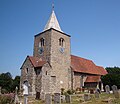History
According to a medieval tradition, Wakering (probably Great Wakering) was the site of a monastery during the 7th century AD. Two Christian cousins of King Ecgberht of Kent, named Æthelred and Æthelberht, were murdered at Eastry, a royal dwelling in the Kingdom of Kent, during King Ecgberht's reign (664–673). They were prevented by a miracle from being buried at Canterbury, and were taken instead to an existing monastery at Wakering in the Kingdom of Essex and enshrined there as saints. Ecgberht's brother and successor, King Hlothhere of Kent, is said by William of Malmesbury to have ridiculed the idea of their sanctity.
The Church of England parish church, dedicated to St Nicholas, dates back to Norman times. The board of rectors or vicars inside begins in the year 1200 with simply "Robert", and the next incumbent equally simply named "Peter". This church is one of the three oldest churches in south-east Essex [2] As well as the parish church, the village also has a United Reformed Church in Chapel Lane, a Methodist church, and an Evangelical (formerly Peculiar People) church on Great Wakering High Street.
Great Wakering has many community links to the Ministry of Defence-governed Foulness Island. The village was badly hit during the North Sea flood of 1953 and locals fear a re-occurrence of the devastation now that tidal levels are rising and flood defences eroding. Of architectural interest is an old brickworks site (now partly demolished) at Star Lane, which was once served by an industrial narrow-gauge railway, the remains of which can still be seen in the bushes. Brick-making was once the main industry in Wakering. The factory finally closed in 1991, but the four towers remained a focal point on the horizon until September 2007, when the towers were demolished. In 2016, planning permission was granted to build new housing on the site. [3]
Much of the land area around Great Wakering is closed to the public as it forms part of a Ministry of Defence (MOD) firing range – the "New Ranges". When firing is not taking place, however, the MOD beach at Wakering Stairs can be accessed via a rough road at Landwick security check-in. It is also possible to go over the MOD land and walk across the range from Cupid's Corner to follow a muddy track to the seawall which offers great views over the Maplin Sands. The MOD beach is a great spot for watching Brent geese and waders. There is much military debris around the area such as old firing targets, railway tracks, a lookout tower and several ruined batteries. There is also access here to the tidal path The Broomway, which leads to Fisherman's Head on Foulness Island.
This page is based on this
Wikipedia article Text is available under the
CC BY-SA 4.0 license; additional terms may apply.
Images, videos and audio are available under their respective licenses.






